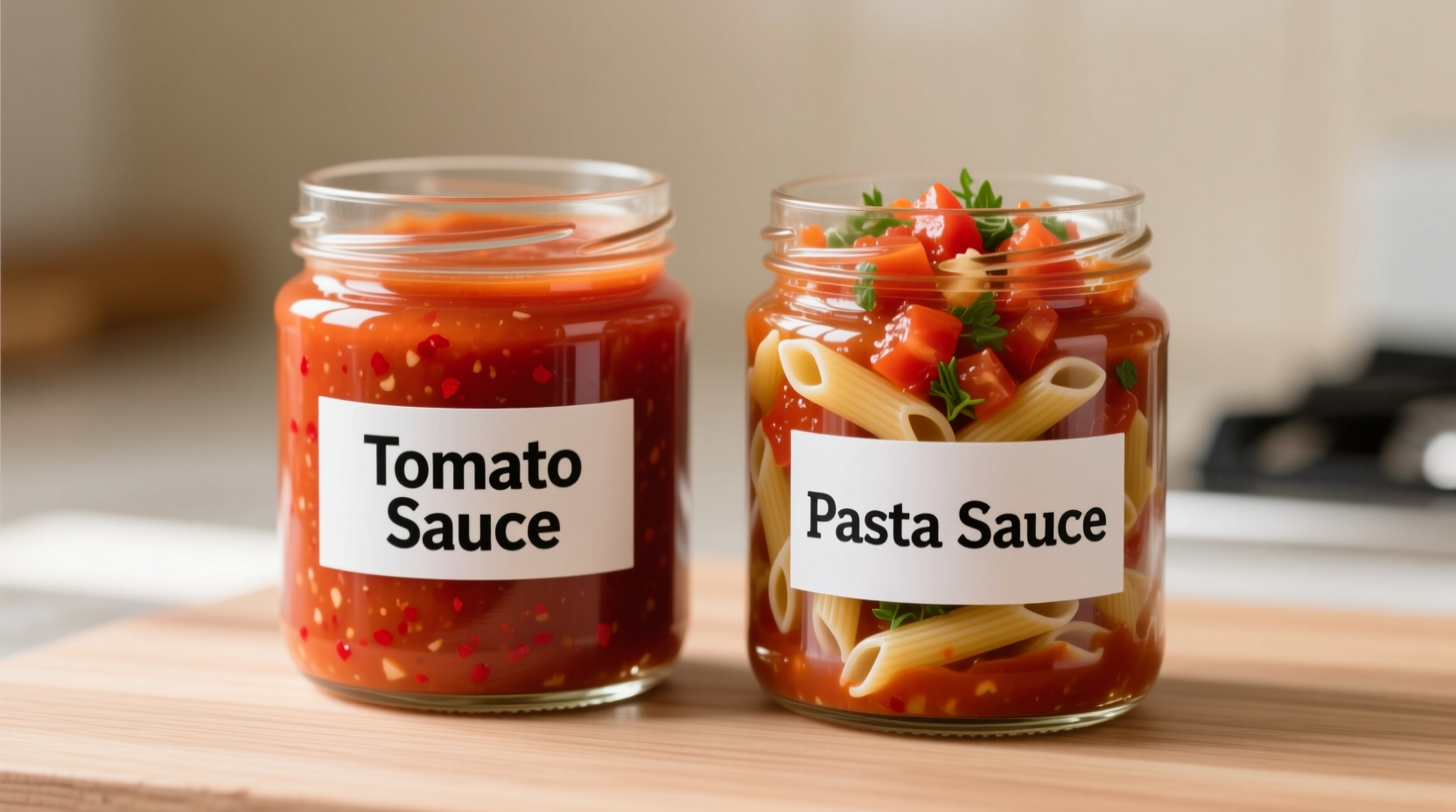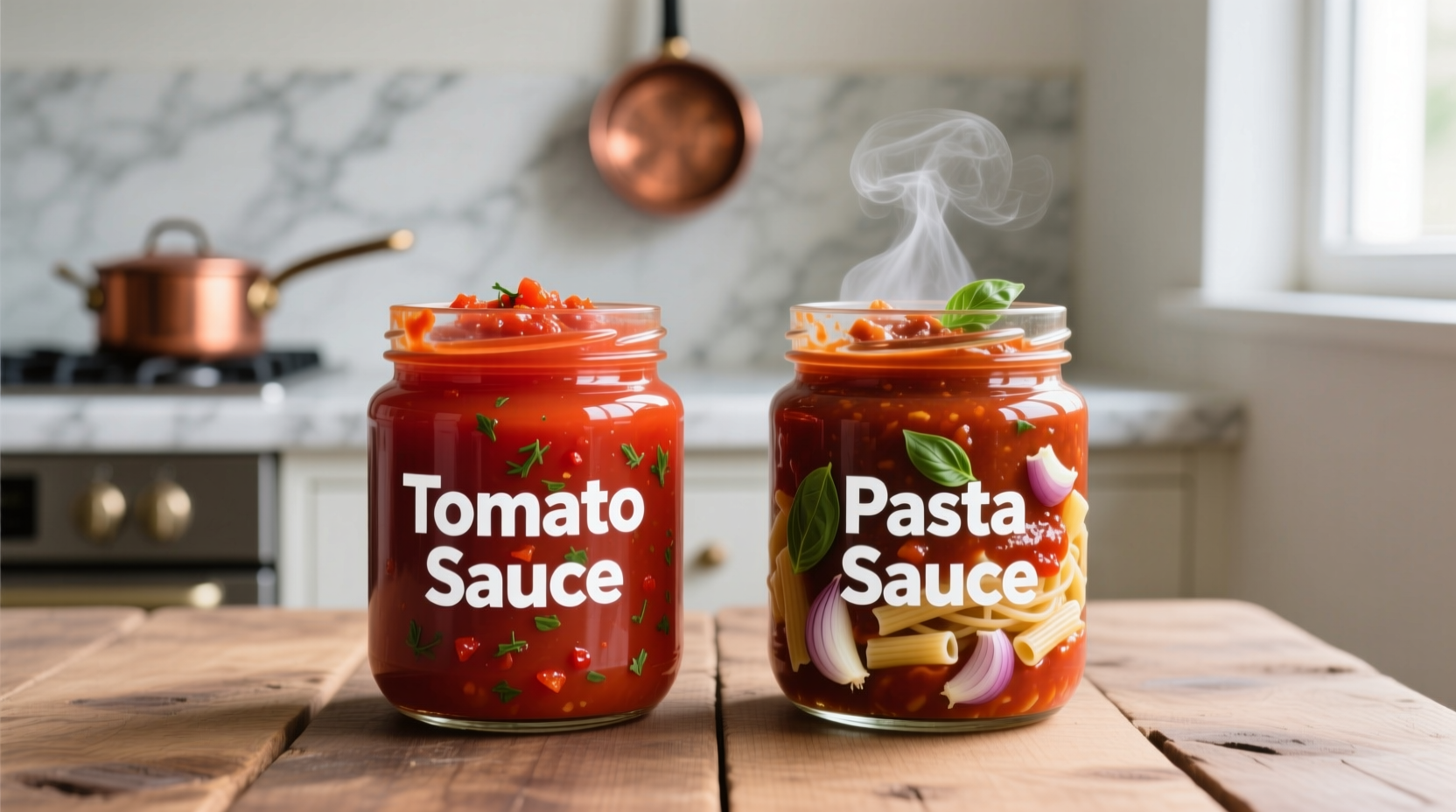Tomato sauce is a basic, unseasoned puree of tomatoes, while pasta sauce is a ready-to-eat seasoned sauce with herbs, vegetables, and sometimes meat. Use tomato sauce as a cooking base; choose pasta sauce for quick meals.
Ever stood in the grocery aisle confused about whether to grab tomato sauce or pasta sauce? You're not alone. This common kitchen dilemma affects home cooks everywhere. Understanding the difference isn't just about labeling—it directly impacts your cooking results and flavor profiles. Let's clarify this confusion once and for all with practical guidance you can use tonight.
Why the Confusion Exists
The terms "tomato sauce" and "pasta sauce" get used interchangeably in many grocery stores, creating understandable confusion. According to the American Culinary Federation, this stems from marketing practices that prioritize consumer familiarity over culinary accuracy. In professional kitchens, these terms represent distinctly different products with specific uses.
Tomato Sauce: The Culinary Building Block
True tomato sauce refers to a simple preparation of cooked, strained tomatoes without added seasonings. The USDA defines commercial tomato sauce as containing at least 24% tomato solids with minimal additives. This versatile base serves as the foundation for countless dishes:
- Typically contains only tomatoes, sometimes with a touch of citric acid for preservation
- Has a smooth, pourable consistency thinner than pasta sauce
- Serves as the starting point for creating custom sauces
- Commonly used in recipes requiring further seasoning and cooking
Professional chefs like those at the Italian Culinary Institute consider tomato sauce the "blank canvas" of Italian cooking—something you build upon rather than serve as-is.
Pasta Sauce: The Ready-to-Use Solution
Pasta sauce represents a complete, ready-to-serve product designed specifically for tossing with pasta. Unlike basic tomato sauce, pasta sauce contains:
- Herbs like basil, oregano, and parsley
- Vegetables such as onions, garlic, and carrots
- Seasonings including salt, pepper, and sometimes sugar
- Optional meat components in varieties like Bolognese
The Italian Food Standards Authority notes that authentic pasta sauces follow regional recipes developed over centuries, each with specific ingredient ratios and preparation methods.
| Feature | Tomato Sauce | Pasta Sauce |
|---|---|---|
| Primary Ingredients | Tomatoes only | Tomatoes plus herbs, vegetables, seasonings |
| Consistency | Thin, pourable | Thicker, clingy texture |
| Preparation Time | Requires additional cooking (15-30+ minutes) | Ready to heat and serve (5-10 minutes) |
| Best Used For | Cooking base for custom sauces, soups, stews | Quick pasta dishes, pizza bases, dipping sauces |
| Shelf Life After Opening | 5-7 days refrigerated | 4-5 days refrigerated |
When to Use Which: Practical Kitchen Guidance
Understanding these differences transforms your cooking approach. Consider these scenarios:
Situations Calling for Tomato Sauce
Reach for tomato sauce when you want complete control over flavor development. This base works best when:
- You're making a custom marinara from scratch
- Creating soups or stews requiring tomato base
- Preparing dishes where you want to control sodium content
- Cooking for dietary restrictions requiring specific ingredient control
Situations Calling for Pasta Sauce
Choose pasta sauce when time matters or you want consistent flavor:
- Weeknight dinners requiring minimal preparation
- When you want authentic regional flavors (arrabbiata, puttanesca)
- For beginners learning Italian cooking techniques
- When creating quick pizza bases or dipping sauces

Common Misconceptions Clarified
Several myths persist about these sauce types. Let's set the record straight:
- Myth: "Pasta sauce is just tomato sauce with extra ingredients"
- Reality: They serve fundamentally different culinary purposes—base versus finished product
- Myth: "All tomato products are interchangeable"
- Reality: Using pasta sauce as a base can lead to overly seasoned, unbalanced dishes
- Myth: "The terms mean the same thing in Italy"
- Reality: In Italy, "sugo" refers to finished sauces while "passata" describes the tomato base
Creating Your Own: Simple Recipes
For the best results, consider making your own versions:
Basic Tomato Sauce (Makes 4 cups)
- 2 lbs (900g) ripe tomatoes, peeled and crushed
- 1 tbsp olive oil
- Pinch of salt
- 1 tsp citric acid (optional, for preservation)
Cook tomatoes with oil and salt over medium heat for 20 minutes until slightly thickened. Strain through fine mesh sieve. Store refrigerated for up to 1 week or freeze for longer storage.
Classic Marinara Pasta Sauce (Makes 6 servings)
- 1 cup homemade tomato sauce
- 3 cloves garlic, minced
- 1 small onion, finely diced
- 2 tbsp olive oil
- 1 tsp dried oregano
- 1 tsp dried basil
- Salt and pepper to taste
Sauté garlic and onion in olive oil until soft. Add tomato sauce and herbs. Simmer 15 minutes. Season with salt and pepper. Toss with freshly cooked pasta.
Reading Labels Like a Pro
When shopping, check ingredient lists to identify what you're actually buying:
- True tomato sauce: Should list only tomatoes (and possibly citric acid or calcium chloride)
- True pasta sauce: Will include multiple seasonings, vegetables, and sometimes meat
- Beware of "tomato pasta sauce"—this marketing term often means seasoned tomato sauce
The FDA Food Labeling Guide requires manufacturers to list ingredients in descending order by weight, helping you identify the primary components at a glance.
Final Verdict: Making the Right Choice
Your sauce selection should match your cooking goals. When time allows and flavor control matters, start with tomato sauce as your base. When convenience is key or you want authentic regional flavors, choose a quality pasta sauce. Understanding this distinction elevates your cooking from following recipes to making informed culinary decisions.











 浙公网安备
33010002000092号
浙公网安备
33010002000092号 浙B2-20120091-4
浙B2-20120091-4